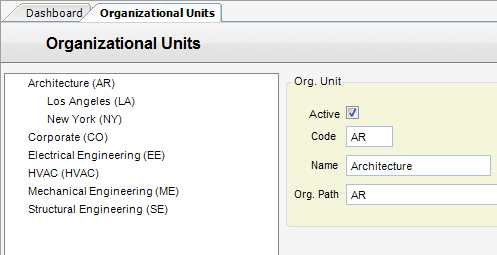Module: General Accounting Applet: Organizational Units |
|
Description: Organizational Units
Quick Explanation
Characteristics of Organizational Units:
| • | Org. Units are used to define the management hierarchy of a company. Examples can be offices, disciplines, business markets, multiple companies. |
| • | InFocus supports unlimited levels of org units. |
| • | In a multi-company scenario, the top level must act as a company. |
| • | Employees are assigned to the lowest level. |
| • | Project ownership and sharing can be assigned at any level, but that level must be established database-wide. |
| • | Revenue and Expense can be marked to follow the owner of the project, the employees assigned cost center, or a mixture of the two |
| • | Org. units are integrated with the Chart of Accounts for Cost/Profit Center reporting. |
| • | Org units are exposed in project management reporting to group project metrics (e.g. cost and revenue) by organizational unit within a project. |
More about Org Units
Organizational units represent the corporate structure. They can contain an infinite number of levels, such as Division, Office, Discipline, or Department. While they can also be used for target markets, this is better handled by using the Market Sector feature in InFocus. Employees, G/L base accounts, and projects can be attached to org. units. Employees are assigned only to the lowest level of the org. structure to ensure proper revenue recognition calculations. Projects can be shared among org. units at the specified level established in Global Settings. They can be owned at any level equal to or above the share level. In the case of project charging, allowable org. units include not only the established owner or sharing org. unit, but all of its children as well.
Example - If a project was assigned to office NY (New York), an employee assigned to NY-AR (office NY-Department Architecture) could charge to it.
Organization Units are established in a tree structure, and each level of the tree is assigned a name. Each element on the tree (called a Node) is given a code. The code must be unique with respect to its parent. Since top nodes do not have a node parent, they must be unique with respect to all other top level nodes. The codes are separated by a single character (a delimiter) as specified in Global Settings.
Note: While not required, it is best to use the same code for the same thing. For instance, if the structure is office/department, it is best to give similar departments the same code across offices. By doing this they can be rolled together in project management reporting and financial statements.
Example - LA-AR and NY-AR would represent architectural departments in New York and Los Angeles. (Fig. 1)
In general, organization units allow for both profit center reporting and the segmentation of accounting.

(Fig.1)